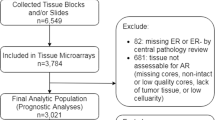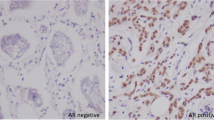Abstract
Background
Breast cancer is a hormone-dependent tumor. Most breast cancer cells have an androgen receptor (AR), but the clinical value of AR expression is unclear.
Methods
AR expression was evaluated in 227 primary breast cancers using immunohistochemistry. The relation of AR expression to clinicopathological factors and biomarkers was analyzed. AR expression was assessed semiquantitatively, and tumors with more than 10% of stained cells were regarded as positive.
Results
The AR-positive rate was higher in smaller tumors (P = 0.045), tumors with negative lymph node metastasis (P = 0.045), scirrhous-type tumors (P < 0.0001), tumors of low histological grade (P = 0.0001), and p53-negative tumors (P = 0.0097). Although AR had no relation to menopausal status, 79% of cases of high AR expression (>50% stained cells) were in postmenopausal women. AR was related to estrogen receptor (ER; P = 0.027) and progesterone receptor (PR; P = 0.016) expression, but showed no relation to human epidermal growth factor receptor type 2 (Her2) expression. Regarding the coexpression of these receptors, 18 of the 42 cases of triple-negative (ER/ PR/ Her2-negative) tumors (43%) were AR-positive.
Conclusion
AR expression is related to low malignancy in breast cancer. The assessment of AR expression may lead to new treatment strategies for breast cancer, especially in postmenopausal women and in women with tumors that show triple negativity for hormone receptors.
Similar content being viewed by others
References
Goldhirsch A, Glick JH, Gelber RD, et al. (2006) Meeting highlights: international expert consensus on the primary therapy of early breast cancer 2005. Ann Oncol 17:878–879
Ruijiter E, van de Kaa C, Miller G, et al. (1999) Molecular genetics and epidemiology of prostate carcinoma. Endocr Rev 20:22–45
Hall RE, Aspinall JO, Horsfall DJ, et al. (1996) Expression of the androgen receptor and an androgen-responsive protein, apolipoprotein D, in human breast cancer. Br J Cancer 74:1175–1180
Kuenen-Boumeester V, Van Der Kwast TH, Claassen CC, et al. (1996) The clinical significance of androgen receptors in breast cancer and their relation to histopathological and cell biological parameters. Eur J Cancer 32A:1560–1565
Ingle JN, Twito DI, Schaid DJ et al. (1991) Combination hormonal therapy with tamoxifen plus fluoxymesterone versus tamoxifen alone in postmenopausal women with metastatic breast cancer. An updated analysis. Cancer 67:886–891
AMA Committee on Research (1960) Androgens and estrogens in the treatment of disseminated mammary carcinoma. JAMA 172:1271–1274
The Japanese Breast Cancer Society (2005) General rules for clinical and pathological recording of breast cancer 2005. Breast Cancer 12:s1–s14
Elston CW, Ellis IO (1991) Pathological prognostic factors in breast cancer. I. The value of histological grade in breast cancer: experience from a large study with long-term follow-up. Histopathology 19:403–410
Labrie F, Luu-The V, Labrie C, et al. (2003) Endocrine and interaction sources of androgens in women: inhibition of breast cancer and other roles of androgens and their precursor dehydroepiandrosterone. Endocr Rev 24:152–182
Somboonporn W, Davis SR (2004) Testosterone effects on the breast: implications for testosterone therapy for women. Endocr Rev 25:374–388
Wong YC, Xie B (2001) The role of androgens in mammary carcinogenesis. Ital J Anat Embryol 106:111–125
Fujita H, Ogata A (2004) Inhibition and stimulation of proliferation by testosterone in human breast cancer cell MCF-7 (in Japanese). Ann Rep Tokyo Metr Inst PH 55:335–338
Mishell DM Jr (1992) Reproductive endocrinology. In: Herbest AL, Mishell DR, Stenchever MA, et al. (eds) Comprehensive gynecology, 2nd edn. Mosby Year Book, St. Louis, pp 79–143
Partin AW, Rodriguez RR (2002) The molecular biology, endocrinology, and physiology of the prostate and seminal vesicles. In: Walsh PC (ed) Campbell’s urology, 8th edn. Saunders, Philadelphia, pp 1237–1296
Winer EP, Piccart-Gebhart J, Rugo HS, et al. (2006) Management of Her2-positive breast cancer. 2006 educational book, American Society of Clinical Oncology, Alexandria
Paik SM, Bryant CH, Park CH, et al. (1998) erbB-2 and response to doxorubicin in patients with axillary lymph node-positive, hormone receptor-negative breast cancer. J Natl Cancer Inst 90:1361–1370
Ortmann J, Prifti S, Bohlmann MK, et al. (2002) Testosterone and 5 alfa-dihydrotestosterone inhibit in vitro growth of human breast cancer cell lines. Gynecol Endocrinol 16:113–120
Rakha EA, EI-Sayed ME, Green AR, et al. (2007) Prognostic markers in triple-negative breast cancer. Cancer 109:25–32
Birrell SN, Roder DM, Horsfall DJ, et al. (1995) Medroxyprogesterone acetate therapy in advanced breast cancer: the predictive value of androgen receptor expression. J Clin Oncol 13:1572–1577
Buchanan G, Birrell SN, Peters AA, et al. (2005) Decreased androgen receptor levels and receptor function in breast cancer contribute to the failure of response to medroxyprogesterone acetate. Cancer Res 65:8487–8496
Johannessen DC, Engan T, di Salle E, et al. (1997) Endocrine and clinical effects of exemestane (PNU 155971), a novel steroidal aromatase inhibitor, in postmenopausal breast cancer patients: a phase I study. Clin Cancer Res 3:1101–1108
Author information
Authors and Affiliations
Corresponding author
About this article
Cite this article
Ogawa, Y., Hai, E., Matsumoto, K. et al. Androgen receptor expression in breast cancer: relationship with clinicopathological factors and biomarkers. Int J Clin Oncol 13, 431–435 (2008). https://doi.org/10.1007/s10147-008-0770-6
Received:
Accepted:
Published:
Issue Date:
DOI: https://doi.org/10.1007/s10147-008-0770-6




